Table of Contents
Kissing Gourami Overview
Waters of the sea are home to some of the most amazing creatures. The kissing gourami is one unique wonder worth keeping in a home aquarium. With extended lips waiting for a hearty kiss, this fish can be an exciting addition to the home tank.
Gouramis belong to the family of Osphronemidae. It consists of more than 95 fish species and at least 15 genera.
The Kissing Gourami is known as Helostoma temminkii in scientific terms. Cuvier first described it in 1829 and named it after a Dutch doctor, Temminck. The genus Helostoma is a monotypic genus with only one species called the Temminkii.
They are native to Indonesia, Pakistan, Malaysia, Thailand, Vietnam, Cambodia, and India.
| Scientific Name: | Helostoma temminkii |
| Family: | Helostomatidae |
| Care Level: | Easy |
| Temperament: | Peaceful(aggressive with small kind) |
| Color: | Pink, Green |
| Lifespan: | Up to 20 yrs |
| Size: | 5-11.8 inch |
| Diet: | Omnivore |
| Minimum Tank Size: | 75 gallons |
| Temperature: | 22 to 28 degrees or (72-82 degrees Fahrenheit) |
| Water conditions: | Hardness: 5 – 35 dGH, pH 6.0-8.8 |
| Tank Mate Compatibility | Other Peaceful Similar Fish |
Appearance of Kissing Gourami

They exhibit some of the most impressive features. Unlike most fish with simple lips, the kissing gourami has outwardly pointed lips. It is not unusual to find their lips locked together in a strange pose. That is perhaps one of the reasons people find these fish exciting and a must-tank addition. It is from this strange phenomenon that they got their name.
The kisser fish comes in three primary colors, as it is commonly known. The most distinct one is silver-green. Some are pink, while others are of the mottled variety.
Pink is not as ordinary as green. It is said that as the fish lives, it loses its pigmentation. This pink kisser fish is often bred in an aquarium because hobbyists love its color.
Green is the most common color. Bordering the anal and dorsal fins is a dark bar. Due to the distinct color difference between tiny and pink, some people think they belong to different species, yet this is not the case.
The mottled kisser is less popular than the other two. However, some hobbyists only look for it and want nothing less.
Typically the Gourami’s body is deep and strongly compressed laterally. It features long-based dorsal and anal fins. 16-18 are spinous rays, and 13-16 are soft for the dorsal fins. Whereas 13-15 spinous rays and 17-19 soft for the anal fins. The posterior soft rays are elongated to form a trailing margin in each fin. We can find that the only rays of the jugular pelvic fins are also elongated. The lateral line of the Gourami’s body divides it into two. Wherein the posterior portion begins below the end of the other. We can also see 43-48 scales present on the line’s length.
Other noticeable features of the fish include:
- Elongated bodies, which are compressed laterally
- It can grow to be 12cm in length. As experienced with other types of fish, the Gourami is bigger in the wild than in captivity.
- Dorsal and anal fins are nearly the same length. In the end, though, they are elongated slightly
- Pectoral fins found behind both sides of the gills are round and a little large.
- On the other hand, pelvic fins found near the belly are long. Its caudal fins are round-shaped
Their lips are fleshy and often pouting. The same lips have white, long teeth lined therein. That is the most distinct feature of these fish.
The Lifespan Of Kissing Gourami
The typical lifespan of a Kissing Gourami is 6-8 years. However, if you take care of your Gourami well and provide a safe and comfortable environment in captivity, they may even live up to 20 years.
Kissing Gourami Size
The typical Kissing Gourami typically grows up to 5-6 inches on the lower end and 11.8 inches for larger specimens. The Gouramis usually grow up to 5 or 6 inches and do not go beyond that when kept in captivity. However, in the wild, they are even seen to go up to 12inches, which is double the size they exhibit in aquariums.
Natural Habitat And Origin
The Kissing Gouramis prefer to dwell in shallow, slow-moving backwaters. When such backwaters are thickly vegetated, they become the preferred habitat for these fish.
We can find them in the tropical Asian regions such as Thailand to Indonesia, Sumatra, Borneo, Java, Cambodia, the Malay Peninsula, etc. They are also possibly found in Eastern Burma.
Gouramis are midwater omnivores that mainly feed on benthic algae and aquatic plants found in their habitat. They also feed on the insects taken from the surface. The Kissing Gouramis also exhibit the feature filter feeding. They use their numerous gill rakers to supplement their diet with small floating organisms in the sea called planktons.
They also possess toothed lips. They use them to rasp algae and food from stones or other surfaces. Such a rasping action draws the similarity with humans. And the lip action gives the illusion of superficial kissing. Hence it justifies the name. The rasping is also done to challenge the dominance.
The spawning period of Kissing Gouramis starts from May to October in Thailand, where they are commonly seen. Since they are open-water egg scatterers, the females initiate the spawning process. It usually takes place under the cover of floating vegetation. However, once the eggs are released, unlike other fish, the adults do not guard them.
The eggs are spherical, smooth, and buoyant. Their initial development takes place rapidly: as a result, the eggs hatch after one day, and then the young ones start free-swimming within the next two days. The Kissing Gouramis usually don’t give much attention to the young ones and survive independently.
Since the Kissers are found in slow-moving vegetated ponds or marshes, they are hardy fish. Hence, they can tolerate a range of water conditions. They possess a hidden structure called the Labyrinth, which helps them utilize oxygen from the air. However, their gills cannot obtain enough oxygen for their survival. Therefore, while creating an artificial habitat, you need to ensure access to the tank zones’ water surface.
Kissing Gourami Care & Tank Set-Up
Kissing Gourami Tank Size and Specifications
Optimum Tank Size For Kissing Gourami
The recommended tank size for Kissing Gourami is at least 75 gallons. Since the Gouramis exhibit a decent size and life expectancy, a tank size of more than 75 gallons or 280 liters shall be optimum. The kissing gourami is a wide swimmer. A wide space is therefore ideal for its happiness.
Tank Shape For Kissing Gourami
Kissing Gouramis are fond of roaming in their habitat. Moreover, since these can grow up to 8-12 inches, they require space. So, a cubical shape would suffice their demands and allow them more length for mobility.
Filter Type
Toxic wastes could accumulate in the tank if the filter is not always shifted or replaced adequately. The best filters for a Kissing Gourami tank would be Natural filters. The ideal way to utilize them is to keep them under extremely glossy light until some dimly lit areas are given—following which, you should replace the filter.
Substrate
These Kissing Gouramis will reveal their colors best on a dark substrate. Therefore, a large gravel substrate is an ideal option. If you combine that with some river rocks, it works great to prevent digging.
The substrate should be large gravel and big rocks to allow it to hide when running away from an aggressive pursuant.
It will also give critical surface areas for optimum algal growth. You can decorate the tank while allowing some retreat areas with some driftwood and rocks in addition to the gravel substrate. You can also add plants, but beware of their plant-feeding nature since they can snack on them. Therefore, large gravels with artificial plants will make ideal substrates.
How Many Kissing Gouramis In A 75-Gallon Tank?
You should keep only one Kissing Gourami in a 75-gallon tank. However, if you want to add more numbers, you need to increase the capacity. The Gouramis are a peaceful community of fish when young. But, as they become adults, they are known to attack the smaller fish and even larger tankmates. It would help if you kept a Gourami with a fish of its size when it grows older.
Water Parameters For Kissing Gourami
Water Temperature
The ideal water temperature for Kissing Gourami is between 22 to 28 degrees or (72-82 degrees Fahrenheit). You must maintain the temperature required to prevent any damage to the labyrinth organ. A higher or lower temperature can cause trauma to the delicate organ.
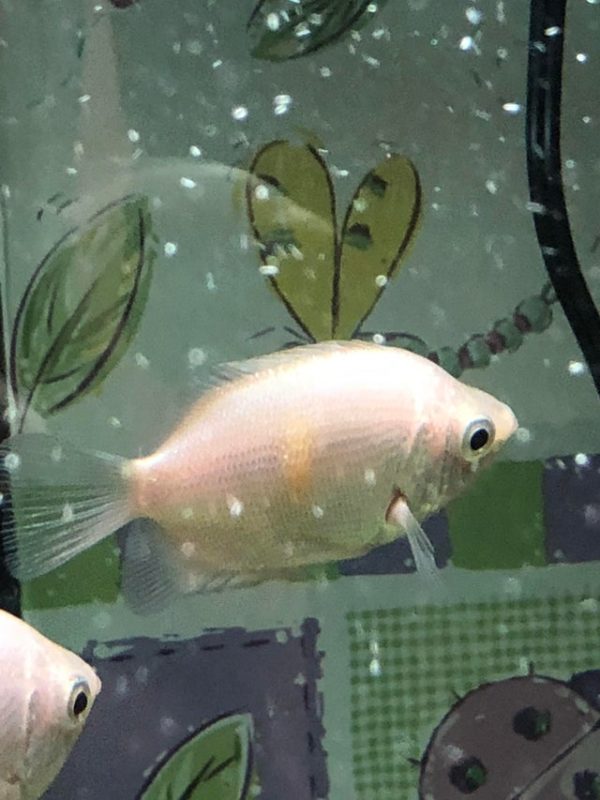
Water Flow Rate
Moderate water movement is required as it allows them to lock their lips during their lip-locking ritual. They also gulp lots of water to keep a sufficient oxygen supply. Lots of water movement can stress the gouramis too. For these three primary reasons, ensure the movement of water is just right. Typically, kissing gouramis swim in all parts of the aquarium but prefer to be at the top or middle of the tank. They are unlikely to interfere with the rocks and gravel at the bottom of the tank.
pH Level
The perfect water pH level for Kissing Gourami is 6.0-8.8. Such a base-inclined pH would ensure a habitat-like atmosphere and not harm physiology.
Water Hardness
The water hardness of a Kissing Gourami tank should lie in the range of 5 – 35 dGH.
Kissing Gourami Tank Landscape
Plants are naturally the Gourami’s favorite meal and should be included in the tank. Plenty of algae must also be added as most fish do well with their presence. Fish colors are best highlighted when there are plenty of algae in the tank. Not to forget is Java Moss as it usually floats on water. The gouramis often appreciate plant cover. The good news is they hardly ever eat the moss. Leave a tiny gap between the cover-slide and water surface to give the fish opportunity to take in atmospheric air.
Best Plants For Kissing Gourami Tanks
- Algae
- Java Moss
- Java Fern
- Floating Plants
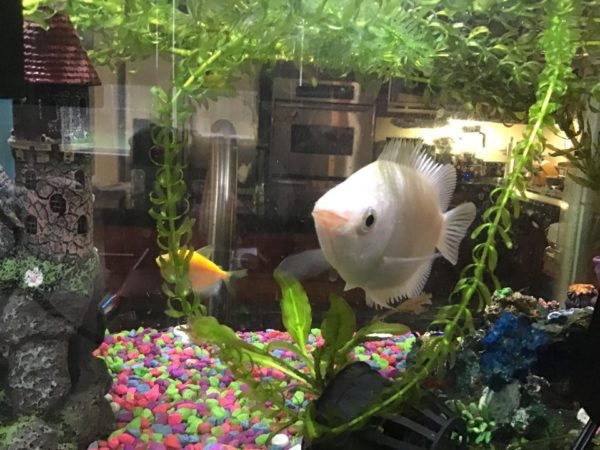
Worst Plants For Kissing Gourami Tanks
- Eichornia
- Poisonous Plants
- Weak Rooted Plants
Decorations for Kissing Gourami Tanks
Kissing Gouramis would love a tank atmosphere with gravel and plants. You can also add driftwood and artificial plants. But keeping algae and Java moss accompanied by a dark gravel substrate is a must-have.
Lighting for Kissing Gourami Tanks
The fish needs average to moderate lighting.
Feeding Kissing Gourami
They are herbivores that appreciate a plant diet. They love algae more and suck the rocks for these . Kissing Gouramis may also be fed on frozen and dried flakes. Tubifex, bloodworms, and brine shrimp are other specialties.
They have an affinity for live worms, earthworms, and glass worms. Cooked peas, lettuce as well as zucchini can be offered too. Always remember to offer just enough feeds. If there are some leftovers, they ought to be removed as the tank may have a foul smell.
Best Diet for Kissing Gourami
Adding a quality flake or pellet food would make a good base to the diet. But it is important to supplement the diet with meaty foods as well. You can supplement it with white worms, bloodworms, or brine shrimp. It is not necessary to follow it exactly, so you can add other suitable substitutes also.
The best diet for your Kissing Gourami should also contain fresh vegetables or vegetable tablets, such as spirulina algae wafers.
You must include these foods in the diet to help them survive and maintain optimum health and appearance.
How Often Should You Feed Kissing Gourami?
Kissing Gourami should typically be fed daily. You can feed your Gouramis once or twice a day. It will also allow them to have regular intervals before their next meal; as a result, they won’t get aggressive.
Kissing Gourami Behaviour And Temperament
The temperament of a Kissing Gourami is semi-aggressive. We can find Gouramis as generally a peaceful species during their juvenile stage. But when they become adults, they tend to get territorial. In some cases, they are tolerant towards other similar-sized fish, but they sometimes become belligerent towards tankmates.
They have been known to attack smaller fish, and sometimes they don’t spare the large tankmates. It is better to keep them with fish their size when they get older. Individuals will show varying degrees of aggression and temperament. While keeping them with their kind, you must ensure that the tank does not get crowded because bullying between gouramis is not an unlikely scenario.
Are Kissing Gouramis Lone Or Societal?
Their juvenile stages suggest their social behavior as they are peaceful towards other communities. However, the adults tend to get territorial.
Kissing Gourami Tank Mates
Ideal Kissing Gourami Tank Mates
- Yoyo Loach.
- Swordtails.
- Tiger Barb.
- Chinese Algae Eaters.
- Angelfish.
- Congo Tetra.
- Rosy Barb.
- Pictus Catfish
Breeding Kissing Gourami
In a home tank, breeding kissing gourami may be hectic. For one, differentiating the males and females is not an easy feat. However, it becomes rounder and huge when the female is full of eggs.
Unlike most other fish, the kisser fish does not build a bubble nest. Instead, it lays its eggs under a leaf, sometimes scattering them in the pond. To be successful in breeding them, one could try the following:
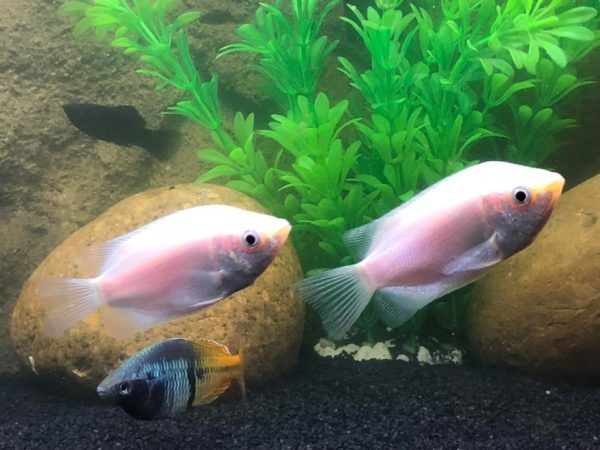
- Acquire a number of the kisser fish because there are high chances of having mixed sexes
- Offer a larger tank when they are of good size that can spawn.
- Provide enough water cover for more large leaves (this offers them privacy)
- Feeding during this period should be thorough.
- Select the more rounded fish as they are likely to be the females. If there are other fish varieties, you can shift them to other tanks to give the Gourami a chance to fry.
- The Gourami releases eggs in their hundreds until they hit or surpass a million. The eggs float on water.
- The fish are known to eat their eggs. If this happens more than it should, you can shift them to give the eggs time to hatch.
Kissing Gourami Breeding Level – Intermediate
Kissing Gourami Sexual Dimorphism?
To distinguish between male and female Kissing Gourami, we must wait till the time of their spawning. That is because both their sexes look almost identical. Differentiating them is usually tricky as they possess their oval shape and thick fleshy lips. It is almost impossible to determine the sex of the Gouramis until their spawning period arrives.
We can distinguish the females during that period as their body becomes rounder as it fills with eggs.
Kissing Gourami Common Diseases and their Treatment
Diseases are not a usual problem while having a Kissing Gourami in your home tank. They are resilient to most diseases.
Moreover, if you maintain the tank properly, the chances of contracting a disease are almost nil. However, being freshwater fish, the common freshwater diseases cannot be ignored for them.
Freshwater Ich
It is a common disease that occurs in most freshwater and marine fish. The primary causative agent of Ich is a protozoan named Ichthyophthirius multifiliis. Although, it can even happen due to poor diet, subpar water, and a stressful environment.
The symptoms of the Ich include
- Small white spots on the body and gills.
- Frequent scraping of the body against objects in the environment.
- Loss of appetite.
- Abnormal hiding behavior.
You can treat this disease with proper medication once you confirm it. Medications that contain formaldehyde, malachite green, copper sulfate, or a combination of all these are effective in treating it.
Facts About Kissing Gourami
People often think the kissing fiasco is some show of love or affection. That is hardly the case. The ritual is usually a show of might.
They are aggressive fish and may not tolerate other species, especially smaller tank, mates. The kissing gouramis are hardy and rarely fall ill if the tank conditions are right. The kissing gourami is an exciting fish to keep in the tank. After knowing how to keep it healthy, there is no reason not to add it to the tank.
Are Kissing Gouramis Right For You?
Kissing Gouramis can be an ideal choice for you since they do not require fancy conditions. In addition to their beauty and visually appealing characteristics, they are tolerant of most other species. However, that can vary according to the individual. They are also resilient to many diseases and do not require much expense.
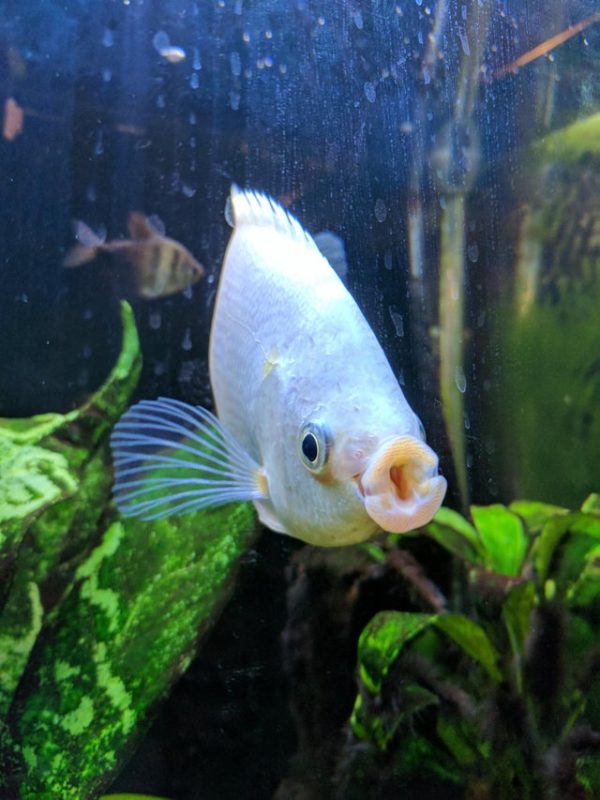
FAQs
How Do Kissing Gouramis Reproduce?
They reproduce by spawning once a year. When the period arrives, the Male and female kissing gourami swim together. Their fertilization takes place externally. It usually happens during monsoons when the females can produce thousands of eggs at a single time.
They move to flooded forests or shallow rivers before the spawning begins. The females initiate the process, and the males follow suit.
During their spawning, the females get upside down to spawn the eggs, and the males release their sperm to fertilize them.
Are Kissing Gouramis Aggressive?
They are generally considered to be peaceful species. But, their peaceful nature is often seen only during their juvenile stages. When they become adults, they tend to get aggressive and territorial to other small fishes.
But in many cases, they are tolerant towards most fishes.
Conclusion
Kissing Gouramis are a fantastic addition to your home tank. Their peculiar kissing appearance can be a lucrative feature.
Moreover, they can come in different colors, pink or green, depending on their mutations.
Their temperament is semi-aggressive, and they are resistant to most water conditions and diseases. They also require only a healthy diet with meaty foods that are not too exotic. Plus, the biggest advantage of a Kissing Gourami is that it has a decent life span of up to 20 years with proper care. Therefore we can say that it can be an excellent choice for all the hobbyists.
